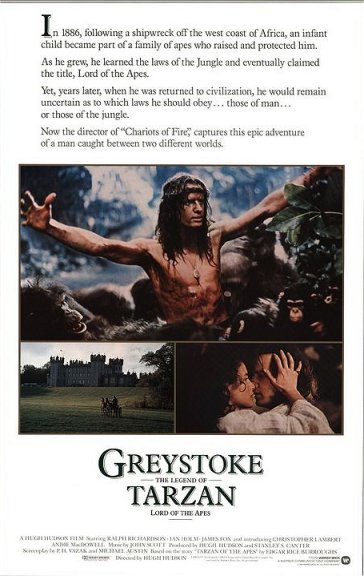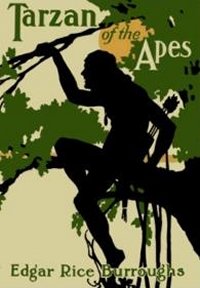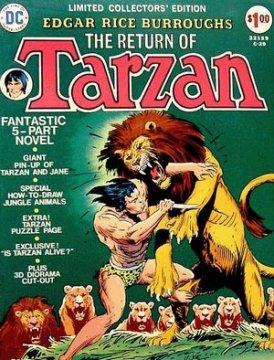
The First and Only Weekly Online Fanzine Devoted to the Life and Works of Edgar Rice Burroughs Since 1996 ~ Over 10,000 Webpages and Webzines in Archive |
 |

The First and Only Weekly Online Fanzine Devoted to the Life and Works of Edgar Rice Burroughs Since 1996 ~ Over 10,000 Webpages and Webzines in Archive |
 |
|
|
|
TARZAN STRONGER THAN EVER
TARZAN ENJOYING NEW WORLDWIDE INTEREST
PHOTO CAPTION: Hulbert Burroughs, son of Edgar Rice Burroughs who created Tarzan
and his son, Denton (sic), display some of the new reprints about the ape-man.
Daytona Beach Morning Journal ~ November 23, 1972
TARZANA, Calif (AP) -- Tarzan is 60 years old and going stronger than ever.
The Edgar Rice Burroughs creation of the ape man is in the midst of a rivival (sic) that started in France, spread to other European countries, to Japan, and back to the United States.
New reprints of the 26 Tarzan books in 16 languages, an art book edition of "Tarzan of the Apes," comic strips, merchandising, toys and advertising gimmicks will push the royalty payments for Burroughs' heirs to several million dollars this year. In addition, numerous magazines are published by Tarzan cultists.
The 1972 income will be the highest ever since the first Tarzan book in 1912, said Bob Hodes, general manager of Edgar Rice Burroughs, Inc., located in a section of Los Angeles named for the ape man in 1930.
The company is housed in an old Spanish-style building Burroughs built on the 550-acre Tarzana Ranch -- since broken up -- and is controlled by his children, John Coleman Burroughs, Hulbert Burroughs and Joan Burroughs Pierce, and a grandson Danton Burroughs. The copyright would have expired in 1968, but Congress, in the process of reviving the Copyright Act, has extended old copyrights.
Not only is the myth of Tarzan undergoing a revival, but Burroughs himself is being elevated to a critical position he never enjoyed before his death in 1950.
In his lifetime Burroughs was regarded as a pulp writer of escapism, and many libraries banned his books. Hulbert Burroughs said, "During the important years of his life when he was writing, Dad had the hell panned out of him by the critics. He never took himself seriously, but I felt the things the critics said hurt him."
But critics are beginning to find new meaning in his works. Some French critics have compared Tarzan to Rousseau's concept of "the natural man." The works of Burne Hogarth, who drew the Tarzan comic strip from 1937 to the mid-50s and was the artist for the new art book, have been displayed at the Museum of Decorative Arts in the Louvre in Paris.
Burroughs also is being taken seriously as a writer of science fiction books. Sam Moscowitz, writing in his book, Under the Moons of Mars," the original title of Burroughs' "A Princess of Mars," said Burroughs humanized science fiction, brought story-telling qualities to it and turned it away from the "flashing light" school of science fiction.
A new book, "Tarzan Lives," contends that Burroughs was not writing fiction at all. And Esquire magazine published an article this year that purported to be an interview with the real Tarzan , Lord Greystoke. In the books, Tarzan was an English peer raised by apes and given the name Tarzan, meaning "white skin" in the language of the great anthropoid apes.
The myth of Tarzan, the escapism and Burroughs' concept of a man living at peace with nature apparently are striking a responsive chord around the world.
"The only explanation I can give is that he's the man we'd all like to be," said Hodes. "He's become a myth rather than superman because we know we can never be superman. But there is absolutely nothing in Burroughs' concept that couldn't be.
"And a lot of kids today are trying to be like that. Not just kids. People are trying to get away from it, finding a new meaning for civilization and living in accordance with the laws of nature.
"Tarzan never tried to change nature to fit his desires. He looked for his own place. That's what's happening to a lot of people today."
Danton Burroughs, 28-year-old grandson of the writer, said, "I envy Tarzan. HIs freedom and the romantic figure that he is. And the acute command of his senses.
Hulbert Burroughs said, "My dad always told me he got the idea from the Romulus and Remus legend. But he told other people he was influenced by Rudyard Kipling's Jungle Book.'
"But what he basically was interested in was how the son of a well-educated lord and lady of England would be raised by the apes. He wanted to see the effect of inheritance and environment."
It was 97 years ago this month that the Frank Munsey-owned pulp called All-Story Magazine introduced the world to a vivid new character with an especially memorable name: Tarzan of the Apes. A book (one of its many, many editons is shown here at right) followed two years later in 1914. The jungle hero would become an icon and, like Sherlock Holmes or Dracula, he became a persistent figure of interest to film and television producers.
In 1918, Elmo Lincoln was the first to portray in him in film but Olympian Johnny Weissmuller, who swung on the vine for 12 films and 16 years, inhabited the character most successfully. Many others followed: Ron Ely was a more erudite Tarzan for 57 episodes of the 1966-1969 television series; the glowering Christopher Lambert took the character back to his feral roots in "Greystoke" in 1984; and Tony Goldwyn gave us singing Ape Man in Disney's 1999 animated hit "Tarzan."
Considering Hollywood's relentless recycling, how long before we see a new Tarzan film? Don't be surprised if next time the mythology is transferred to a setting with more special effects opportunities; we might see a spaceship crash leave an orphaned infant alone on a jungle planet with talking apes, or perhaps a post-apocalyptic Earth where the jungle is the ruins of Manhattan.
The ruler of the jungle has a pulp heritage and, just like with his loincloth, he gets very little coverage when it comes to literary academia. Even the less-judgmental scholars of pop culture don't seem to dwell on Tarzan much these days. But here in his anniversary month, I thought it would be nice to present an excerpt from one especially memorable appreciation of Tarzan and his creator, Edgar Rice Burroughs; this essay was written by Gore Vidal for Esquire magazine and published in December of 1963. I've added images from Tarzan's long swing through popular culture.
-- Geoff Boucher
 |

 |


We
want to hear from you... E-Mail
ERBzine@westman.wave.ca
From

tarzana.ca
The
Fantastic Worlds of Edgar Rice Burroughs
![]()

![]()
![]()
BILL
HILLMAN: Editor and Webmaster
BILL
& SUE-ON HILLMAN ECLECTIC STUDIO
ERB
Text, ERB Images and Tarzan® are ©Edgar Rice Burroughs, Inc.-
All Rights Reserved.
All
Original Work ©1996-2010 by Bill Hillman and/or Contributing Authors/Owners
No
part of this web site may be reproduced without permission from the respective
owners.